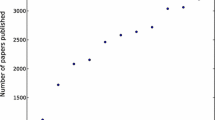Abstract
We analyze the temporal evolution of emerging fields within several scientific disciplines in terms of numbers of authors and publications. From bibliographic searches we construct databases of authors, papers, and their dates of publication. We show that the temporal development of each field, while different in detail, is well described by population contagion models, suitably adapted from epidemiology to reflect the dynamics of scientific interaction. Dynamical parameters are estimated and discussed to reflect fundamental characteristics of the field, such as time of apprenticeship and recruitment rate. We also show that fields are characterized by simple scaling laws relating numbers of new publications to new authors, with exponents that reflect increasing or decreasing returns in scientific productivity.
Similar content being viewed by others
References
Derek J. de Solla Price, Little Science, Big Science, New York: Columbia University Press, 1963.
T. Braun, E. Bujdosó, A. Schubert, The Literature of Analytical Chemistry: A Scientometric Evaluation, Boca Raton, FL: CRC Press, 1987.
W. Goffman, V. A. Newill, Generalization of epidemic theory: An application to the transmission of ideas, Nature, 204 (1964) 225–228; W. Goffman, Mathematical approach to the spread of scientific ideas: The history of mast cell research, Nature, 212 (1966) 449–452; W. Goffman, G. Harmon, Mathematical approach to the prediction of scientific discovery, Nature, 229 (1971) 103–104.
E. Garfield, The epidemiology of knowledge and the spread of scientific information, Current Contents, 35 (1980) 5–10.
A. N. Tabah, Literature dynamics: Studies of growth, diffusion, and epidemics, Annual Review of Information Science and Technology (ASIS), 34 (1999) 249–286.
T. Braun, The epidemic spread of fullerene research, Angew. Chem. Int. Ed. Engl., 31 (1992) 588–589.
M. E. J. Newman, Scientific collaboration networks: I. Network construction and fundamental results, Phys. Rev. E, 64 (2001) 016131; M. E. J. Newman, Scientific collaboration networks: II. Shortest paths, weighted networks, and centrality, Phys. Rev. E, 64 (2001) 016132; M. E. J. Newman, The structure of scientific collaboration networks, Proc. Natl. Acad. Sci. USA, 101 (2004) 404–409.
S. Redner, Citations statistics from 110 years of Physical Review, Physics Today, 58 (2005) 49.
R. M. Shiffrin, K. Börner, Mapping knowledge domains, Proc. Natl. Acad. Sci. USA, 98 (2001) 5183–5185.
C. Chen, Searching for intellectual turning points: Progressive knowledge domain visualization, Proc. Natl. Acad. Sci. USA (suppl.), 101 (2004) 5303–5310.
K. W. Boyack, R. Klavans, K. Börner, Mapping the backbone of science, Scientometrics, 64 (2005) 351–374.
L. M. A. Bettencourt, A. Cintron-Arias, D. I. Kaiser, C. Castillo-Chávez, The power of a good idea: Quantitative modeling of the spread of ideas from epidemiological models, Physica A, 364 (2006) 513–536.
F. Brauer, C. Castillo-Chávez, Mathematical Models in Population Biology and Epidemiology. Texts in Applied Mathematics, 40, New York: Springer-Verlag, 2001.
K. L. Cooke, D. A. Allers, C. Castillo-Chávez, Mixing patterns in models of AIDS, In: O. Arino, D. Axelrod, M. Kimmel (Eds), Mathematical Population Dynamics, New York: Dekker, 1991, pp. 297–309; C. Castillo-Chávez, K. Cooke, W. Huang, S. A. Levin, The role of long incubation periods in the dynamics of HIV/AIDS, part 1: Single population models, J. Math. Biol., 27 (1989) 373–398.
A. H. Guth, The inflationary universe: A possible solution to the horizon and flatness problems, Phys. Rev. D, 23 (1981) 347–356; A. D. Linde, A new inflationary universe scenario: A possible solution of the horizon, flatness, homogeniety, isotropy, and primordial monopole problems, Phys Lett B, 108 (1982) 389–393; A. Albrecht, P. J. Steinhardt, Cosmology for Grand Unified Theories with radiatively induced symmetry breaking, Phys. Rev. Lett., 48 (1982) 1220–1223.
A. H. Guth, D. I. Kaiser, Inflationary cosmology: Exploring the universe from the smallest to the largest scales, Science, 307 (2005) 884–890.
T. W. B. Kibble, Topology of cosmic domains and strings, J. Phys. A, 9 (1976) 1387–1398.
A. Vilenkin, E. P. S. Shellard, Cosmic Strings and Other Topological Defects, New York: Cambridge University Press, 1994.
S. B. Prusiner, Scrapie prions, Annu. Rev. Microbiol., 43 (1989) 345–374.
K. Weigmann, Fashion of the times, EMBO Rep., 5 (11) (2004) 1028–1031.
S. B. Prusiner, Prions, In: Les Prix Nobel 1997, Stockholm: Nobel Foundation, 1998, 262–323. Reprinted in Proc. Natl. Acad. Sci. USA, 95 (1998) 13363–13383.
S. Iijima, Helical microtubules of graphitic carbon, Nature, 354 (1991) 56–58.
T. Braun, A. Schubert, S. Zsindely, Nanoscience and nanotechnology on the balance, Scientometrics, 38 (1997) 321–325.
T. Braun, S. Zsindely, I. Dióspatonyi, E. Zádor, Gatekeeping patterns in nano-titled journals, Scientometrics, 70 (2007) 651–667.
R. P. Feynman, Simulating Physics with Computers, Int. J. Theor. Phys., 21 (1982) 467; Quantum mechanical computers, Found. Phys., 16 (1986) 507.
D. Deutsch, Quantum Theory, the Church-Turing Principle and the Universal Quantum Computer, Proc. R. Soc. Lond. A, 400 (1985) 97.
P. W. Shor, Polynomial time algorithms for prime factorization and discrete logarithms on a quantum computer, Proc. 35th Ann. IEEE Symp. on Foundations of Computer Science, S. Goldwater (Ed.), Los Alamitos, CA: Computer Society Press, 1994; L. K. Grover, A fast quantum mechanical algorithm for database search, Proceedings, 28th Annual ACM Symposium on the Theory of Computing, 212 (1996).
D. G. Cory, A. F. Fahmy, T. F. Havel, Ensemble quantum computing by NMR spectroscopy, Proc Natl. Acad. Sci. USA, 94 (1997) 1634–1639.
L. M. A. Bettencourt, J. Lobo, D. Helbing, C. Kühnert, G. B. West, Growth, innovation, scaling and the pace of life in cities, Proc. Natl. Acad. Sci. USA, 104 (2007) 7301–7306.
See, e.g., C. Mody, How probe microscopists became nanotechnologists, In: D. Baird, A. Nordmann, J. Schummer (Eds), Discovering the Nanoscale, Amsterdam: IOS Press, 2004, pp. 119–133; L. Zucker, M. Darby, Socio-economic impact of nanoscale science: Initial results and NanoBank, National Bureau of Economic Research, Cambridge, MA, Working Paper 11181 (2005); and the special issue of Scientometrics, 70 (2007) 541–880.
Author information
Authors and Affiliations
Corresponding author
Rights and permissions
About this article
Cite this article
Bettencourt, L.M.A., Kaiser, D.I., Kaur, J. et al. Population modeling of the emergence and development of scientific fields. Scientometrics 75, 495–518 (2008). https://doi.org/10.1007/s11192-007-1888-4
Received:
Published:
Issue Date:
DOI: https://doi.org/10.1007/s11192-007-1888-4




